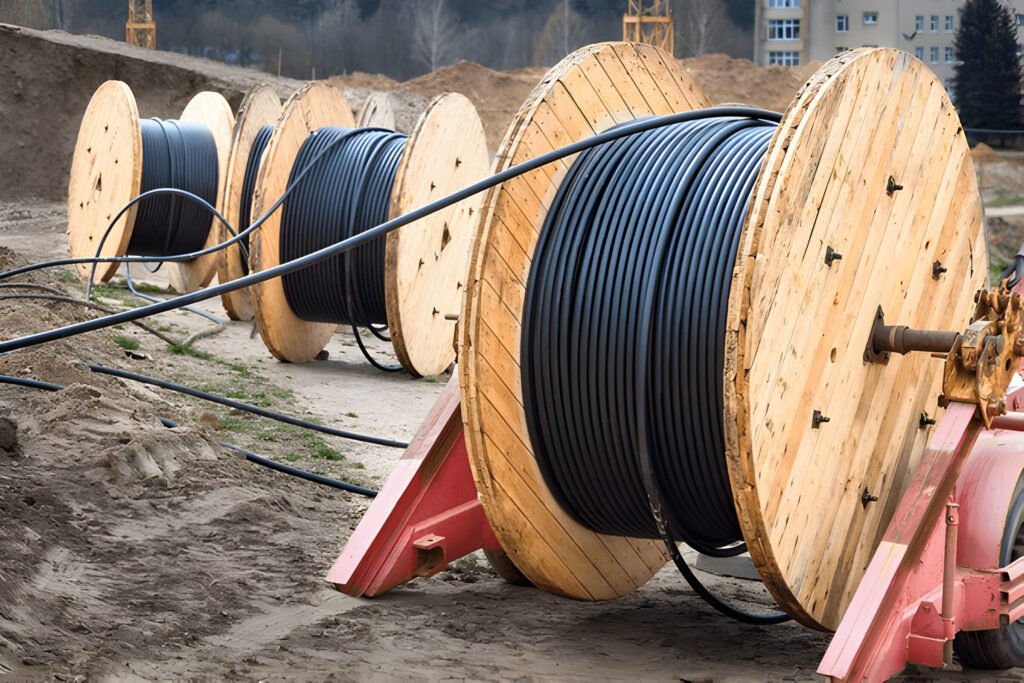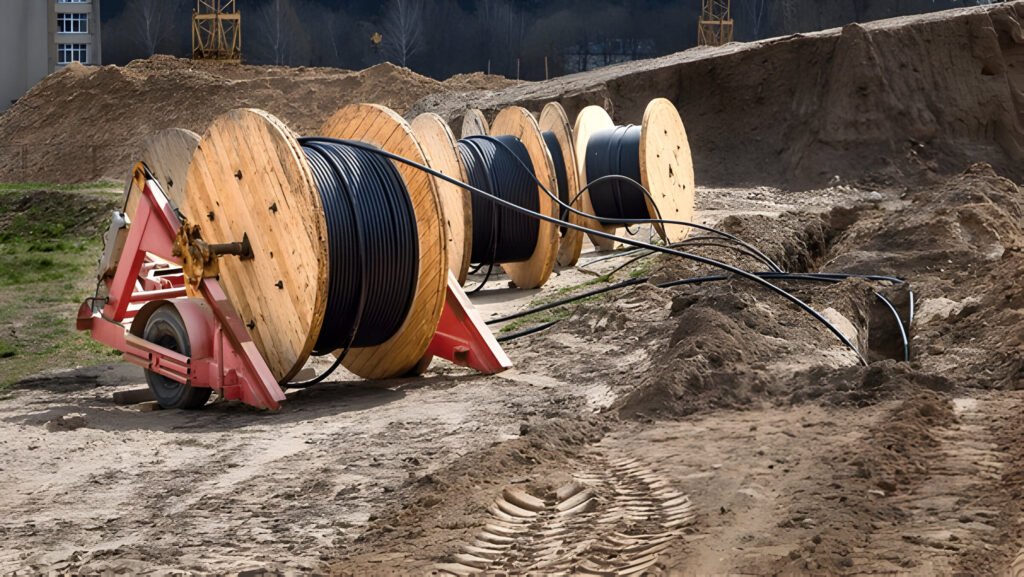The global fiber optic network, spanning over 1.8 million km as of 2025 (per TeleGeography), is a cornerstone of 5G rollouts, rural broadband initiatives, and smart infrastructure. A critical aspect of deploying these cables is determining their burial depth, which ensures protection from environmental hazards, human activity, and regulatory compliance. This guide explores the technical standards, influencing factors, installation practices, and future trends for burying fiber optic cables. Tailored for professionals sourcing solutions from CommMesh, it offers insights to optimize network longevity and performance.
Introduction to Fiber Optic Cable Burial Depth
Fiber optic cables transmit data as light pulses through a core, offering bandwidths up to 400 Gbps via wavelength-division multiplexing (WDM). Burying these cables protects them from physical damage, weather, and unauthorized access, but the depth varies based on location, cable type, and local regulations. Typically, burial depths range from 0.3 to 1.5 meters, balancing protection with installation cost and accessibility. With fiber deployments accelerating in urban and rural areas, understanding these depths is essential for efficient planning and maintenance.

Standard Burial Depths for Fiber Optic Cables
Burial depths are guided by international and regional standards, tailored to environmental and safety needs:
- General Industry Standards
- The International Telecommunication Union (ITU) and Institute of Electrical and Electronics Engineers (IEEE) recommend a minimum depth of 0.6 meters for urban areas and 1.0 meters for rural or agricultural zones to protect against frost, plows, and erosion.
- The National Electrical Code (NEC) in the U.S. specifies 0.6–1.2 meters for telecommunications cables burial depth, depending on soil type and traffic load.
- Regional Variations
- North America: The U.S. and Canada often mandate 1.0–1.2 meters in rural areas to counter frost lines (e.g., 1.2 m in Minnesota) and 0.6–0.9 m in urban settings with concrete encasement.
- Europe: The European Telecommunications Standards Institute (ETSI) suggests 0.8–1.0 meters, with 0.5 m allowed in urban ducts.
- Asia: China and India require 1.0–1.5 meters in rural zones to protect against monsoons and agricultural activity, while urban depths are 0.6–0.9 m.
- Cable Type Considerations
- Armored Cables: Often buried at 1.0–1.5 meters due to their steel tape protection, resisting 50 kN/m² soil pressure.
- Unarmored Cables: Typically 0.6–0.9 meters, relying on conduits or ducts for added safety.
- Aerial-to-Buried Transitions: Depths increase to 1.2 meters near transition points to avoid 1000 N/cm crush loads.
Factors Influencing Burial Depth
Several technical and environmental factors dictate the optimal burial depth:
- Soil Conditions
- Rocky Terrain: Requires 1.2–1.5 meters to avoid 1000 N/cm crush damage, common in mountainous regions.
- Sandy Soil: Allows 0.6–0.9 meters, as erosion risk is lower, but water ingress (0.1 MPa) necessitates conduits.
- Clay or Loam: 1.0–1.2 meters to counter 50 kN/m² pressure and frost heave.
- Climate and Weather
- Frost Lines: Depths of 1.0–1.5 meters protect against freezing (e.g., -20°C in northern Europe), where ice expansion exerts 10 kN/m².
- Flood Zones: 1.2–1.5 meters prevent 0.1 MPa water pressure, critical in monsoon-prone areas like Southeast Asia.
- UV Exposure: Shallow depths (0.3–0.6 m) in ducts avoid jacket degradation, but require UV-resistant materials.
- Human Activity
- Urban Areas: 0.6–0.9 meters to avoid construction equipment (e.g., 500 N/cm load) and pedestrian traffic.
- Agricultural Zones: 1.0–1.5 meters to evade plows (1000 N/cm) and livestock.
- Road Crossings: 1.2–1.5 meters with concrete slabs to withstand 2000 N/cm traffic loads.
- Cable Design
- Armored Cables: 1000–2000 N/cm crush resistance allows 1.0–1.2 m depths.
- Unarmored Cables: 500 N/cm resistance limits depths to 0.6–0.9 m unless ducted.
- Multi-Core Cables: 144-core designs may require 1.2 m to support 3000 N tensile strength during installation.

Installation Practices for Burial Depth
Proper installation ensures cable longevity:
- Trenching and Digging
- Trenches are excavated to 0.6–1.5 meters using backhoes or micro-trenching (10–15 cm wide), reducing disruption by 30%.
- Sand or gravel bedding (10–15 cm) cushions the cable, absorbing 500 N/cm pressure.
- Cable Placement
- Cables are laid with a 10–30 mm bend radius to avoid 0.01% signal loss, secured with 1000 N tensile strength.
- Separation from power lines (0.3–0.6 m) prevents electromagnetic interference (EMI) of 0.1 dB.
- Backfilling and Marking
- Soil or warning tape (0.2 m above cable) indicates depth, complying with OSHA standards.
- Compaction at 50 kN/m² ensures stability without 100 N/cm crush risk.
- Testing Post-Installation
- Optical Time-Domain Reflectometer (OTDR) tests measure attenuation (<0.2 dB/km) and reflection (>-50 dB) at 1310/1550 nm.
- Crush tests (1000 N/cm) verify integrity at specified depths.
Case Studies on Burial Depth
Real-world deployments highlight practical burial depth applications as of 2025:
- Rural Broadband in the U.S.
- Project: Verizon’s 2025 initiative to connect 500,000 rural homes, spanning 3000 km.
- Depth: 1.0–1.2 meters, adhering to NEC standards, to counter frost lines and agricultural plows (1000 N/cm).
- Outcome: Armored cables with 2000 N/cm crush resistance reduced failures by 15%, with OTDR tests showing <0.2 dB/km loss.
- Urban 5G Rollout in Europe
- Project: Vodafone’s deployment of 2000 km in German cities, supporting 5G fronthaul.
- Depth: 0.6–0.9 meters in ducts, per ETSI guidelines, avoiding 500 N/cm construction loads.
- Outcome: Unarmored multi-core cables saved 20% on installation costs, with 99.9% uptime.
- Monsoon-Prone Regions in India
- Project: BSNL’s 4000 km rural network expansion.
- Depth: 1.2–1.5 meters to resist 0.1 MPa water pressure and 50 kN/m² soil pressure.
- Outcome: Steel-tape armored cables with water-blocking gel achieved a 25-year lifespan, per initial tests.

Challenges in Determining Burial Depth
Burying fiber optic cables presents several technical hurdles:
- Environmental Variability
- Frost Heave: Ice expansion (10 kN/m²) in northern regions can shift cables at 1.0 m, causing 0.1 dB loss. Solution: Depths of 1.2–1.5 m with insulation.
- Erosion: Sandy soils erode 0.5 m annually in coastal areas, risking exposure. Solution: Conduits or 1.0 m minimum depth.
- Human Interference
- Construction Damage: Urban digs (500 N/cm) at 0.6 m can crush unarmored cables. Solution: Ducts or 0.9 m depth with warning tape.
- Theft/Vandalism: Shallow depths (0.3 m) invite tampering. Solution: 1.0 m minimum with security markers.
- Installation Errors
- Inaccurate Depth: 10–20% of trenches deviate by 0.2 m, risking 100 N/cm pressure. Solution: Laser-guided trenching ensures ±0.05 m accuracy.
- Compaction Issues: Poor backfill (20 kN/m²) causes settling. Solution: 50 kN/m² compaction standards.
Cost Considerations for Burial Depth
Burial depth directly affects project economics:
- Material Costs
- Shallow Depths (0.3–0.6 m): $0.30–$1.00/meter for unarmored cables, with minimal bedding.
- Deeper Depths (1.0–1.5 m): $0.80–$3.00/meter for armored cables, including gel and steel tape.
- Difference: 200–300% cost increase for deeper protection.
- Installation Costs
- Shallow: $200–$500/km, using micro-trenching (10 cm wide).
- Deep: $600–$1200/km, requiring backhoes and 1.5 m trenches.
- Difference: 200–240% higher for deeper installs, with 30% labor impact.
- Long-Term Maintenance
- Shallow: 10–15% annual cost ($20–$30/km) due to exposure risks.
- Deep: 5–10% ($30–$60/km) for 20–30 year lifespans.
- Difference: Deeper burial reduces maintenance by 50% over time.
| Aspect | Shallow (0.3–0.6 m) | Deep (1.0–1.5 m) | Difference |
|---|---|---|---|
| Material Cost | $0.30–$1.00/meter | $0.80–$3.00/meter | 200–300% higher deep |
| Installation Cost | $200–$500/km | $600–$1200/km | 200–240% higher deep |
| Maintenance Cost | 10–15% ($20–$30/km) | 5–10% ($30–$60/km) | 50% less deep |

Future Trends in Burial Depth Practices
Innovations are shaping burial strategies as of 2025:
- Advanced Materials
- Self-Healing Jackets: Polymers that seal 0.1 mm cracks reduce maintenance at 1.0 m depths by 20%.
- Lightweight Armor: Aluminum tape cuts weight by 15%, enabling 1.2 m burials with 1000 N/cm resistance.
- Automation and Precision
- Robotic Trenching: Systems achieve 50 m/hour with ±0.05 m accuracy, cutting labor costs by 30% for 1.5 m depths.
- AI Mapping: Predicts soil and frost risks, optimizing depths to 0.8–1.2 m with 95% accuracy.
- Sustainability
- Bio-Based Bedding: Degradable materials reduce environmental impact at 1.0 m depths, aligning with 2025 green standards.
- Reduced Digging: Micro-trenching to 0.6 m with ducts saves 40% energy in urban zones.
Conclusion
Determining how deep fiber optic cables are buried—ranging from 0.3 to 1.5 meters—depends on standards, soil conditions, climate, human activity, and cable design. Deeper burials (1.0–1.5 m) protect against frost, floods, and heavy loads, offering 20–30 year lifespans, while shallower depths (0.3–0.6 m) suit urban ducts with 10–20 year durability. Case studies from the U.S., Europe, and India underscore these practices, despite challenges like erosion and installation errors. Future trends, including automation and sustainable materials, promise enhanced efficiency. For tailored burial solutions, explore CommMesh.

